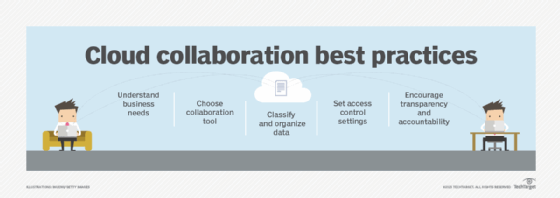cloud collaboration
What is cloud collaboration?
Cloud collaboration is a type of enterprise collaboration that allows employees to work together on documents and other data types, which are stored off-premises and outside of the company firewall. Employees use a cloud-based collaboration platform to share, edit and work together on projects. Cloud collaboration lets two or more people work on a project at once.
A cloud collaboration project begins when one user creates a file or document and gives access to other individuals. For example, the project creator may share a link to the file that lets others view and edit it. The other users can edit and change the document at any time, including when other members of the project team are working on it. Changes are saved and synced so all users see the same version of the project.
Cloud collaboration tools frequently provide a way for project participants to see who else is viewing the document and to communicate with other team members while working, using comments or a chat function. Users can implement integrations that let them set up email alerts so they know when a file is changed. These and other functions increase worker efficiency and productivity.
Why is cloud collaboration important?
The increasing availability of remote work has contributed to cloud collaboration's popularity. Remote workers must access documents and communicate with teammates from various locations and at different times. Cloud collaboration gives geographically distributed workers the flexibility to work with teammates in real time.
Cloud collaboration also enables better tracking, storage and version control of documents. All changes made to a document or file are recorded, stored and presented to others via the cloud so elements of a project can be reviewed and revisited. These features centralize the work of remote and hybrid teams in one location.
McKinsey and Company's 2022 American Opportunity Survey found that 35% of respondents said they have the option to work full time remotely, presenting opportunities to use cloud collaboration.
Cloud collaboration also centralizes access control. These tools let a company efficiently decide which team members have access to other team members and content as well as the best way to facilitate team collaboration.
Cloud collaboration benefits and drawbacks
Cloud-based collaboration tools can have a positive effect on group communication and teamwork. The benefits of cloud collaboration include the following:
- Efficiency. Cloud collaboration enables asynchronous communication and editing. Users don't have to wait for a teammate to finish their work on a document; instead, they can make contributions at any time. Work gets done faster because workers can access documents when they're ready to contribute.
- Flexibility. The cloud lets team members work from anywhere and across a range of time zones. All they need is an internet connection and access to the right documents.
- Real-time collaboration. Team members collaborate in real time. As soon as a change is made to a document, other team members see the change. They know when a change was made and who made it.
- Access control. Cloud computing and cloud collaboration tools help project managers and team members control permission levels as well as access to information and who can make changes. This streamlines processes by limiting the amount of information each team member sees. It also ensures privacy and data security because only authenticated users have access to sensitive documents.
- Inclusivity. Collaboration tools allow many team members to contribute to a project if broad participation is needed.
- Version control. Team members can see a document or a conversation's history to optimize workflow and processes and then backtrack, if necessary.
Cloud collaboration also has downsides:
- Application overlap. It can be difficult to find one app or cloud service that suits all collaboration needs. As a result, some organizations end up using several cloud collaboration software-as-a-service applications with overlapping functions. This can result in duplicate efforts and wasted money.
- Difficulty monitoring. When employees work remotely and collaborate over the internet, it can be difficult to track progress and workflow.
- Information overload. Ensuring employees have the permissions and access they need to do their work can get complicated. Companies must find the balance between too little and too much information for workers using collaboration tools.
- Lack of collaboration strategy. Even if a team has one or several suitable cloud collaboration tools, it won't be effective without an established communication strategy.

Cloud collaboration best practices
Best practices to collaborate effectively using the cloud include the following:
- Consider access settings. Administrators and managers in IT departments must carefully organize teams to ensure that the right employees have access to the information they need. Guest access should be configured according to the organization's risk tolerance. There is always a security risk when allowing guest access to a network.
- Choose a tool carefully. Admins should thoroughly vet vendors when choosing a collaboration tool to ensure that the tool is secure and aligns with the organization's business needs.
- Use layered security. Multiple layers of cloud collaboration security should be used to protect assets from threats beyond the company firewall.
- Train end users. Once a tool is selected, organizations should train teams to use the tool according to security standards. Transparency and accountability should be enforced to build trust among managers and employees.
- Visualize data. Collaboration tools provide real-time performance and management data. Using data visualization can help organizations see the full picture of how a team is performing.
Cloud collaboration tools
Cloud collaboration capabilities come in a variety of different applications and provide various features, including version control, custom permission levels and real-time communication. Some standard features of cloud collaboration software tools include the following:
- Team communication. Applications like Cisco Webex, Microsoft Teams, Skype and Zoom enable video conferencing, instant messaging and document sharing.
- Cloud storage. Tools for document storage, such as Dropbox, Google Docs and WeTransfer, let users share files as well as store and edit them in real time.
- Project management. Cloud-based project management tools provide capabilities such as progress monitoring, objective tracking and task scheduling using instant messaging, Kanban charts, data visualization and dynamic social feeds. Project management tools that enable cloud collaboration include Asana, Teams and Trello.
- Visualize data. Tools such as Atlassian's Bitbucket and Microsoft's GitHub let developers share, comment on and edit each other's code.
Choosing a collaboration tool is an important part of enterprise cloud collaboration. Learn about these 13 collaboration tools.







